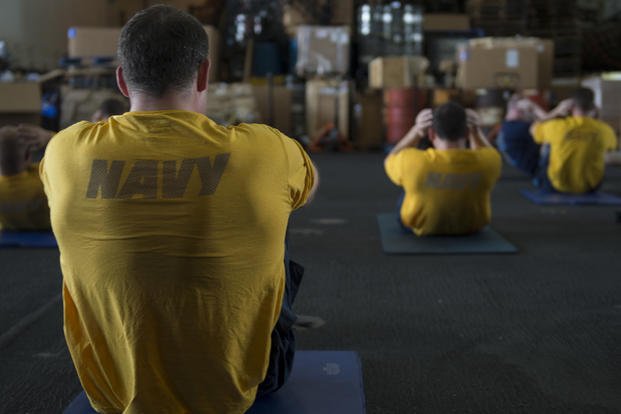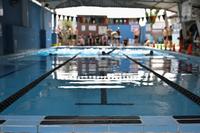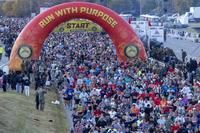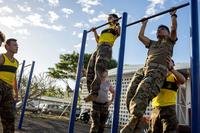I had the opportunity to speak at a major Naval command with the command's division remedial physical fitness test (PFT) leaders. Many of the issues the Navy is having with the physical mission stretch across the board within all branches of the military.
The problems many group PT leaders are having are the following:
- Group PT ideas
- Motivation
- Foundation building
- Group PT
- Push-ups
- Running and sit-ups
- PFT anxiety
- Tape test
Group PT Ideas
- Motivation to reach above the minimum standards
- Foundation building for remedial PT (flexibility/endurance)
- Pre-PFT meals for better performance
- Upper-body strength on push-ups and abdominal exercises
- Running speed for the 1.5-mile timed run
- Body-fat percentage
The topics above are presented below in general terms, with more detailed explanations in the previous written articles located in the Military.com Article Archive links provided.
Motivation
If I had the answer as to how to motivate people to become fitter and healthier, I probably would have a New York Times bestseller. People are different, and some things will motivate one to exercise and not work for others. The motivating factors usually include, but are not limited to, the following:
1. Future deployment to a war zone. The chances of deploying to a war zone occur within many branches, whether or not you are in a combat unit or at a permanent duty station within the United States. Many people want to be smaller targets and seek to lose weight when traveling to Iraq or Afghanistan.
Others just want to be fit to survive and build their abilities to run or ruck over long distances. Building strength and endurance is the key to this goal. Think of working out as a means to "gain fitness," not as a means to "lose weight." Before you know it, you are fit and you have lost weight.
2. Career options. To further your career, you need to score above average on your physical fitness tests. And conversely, if you fail your PT/run test or your body-fat test, you easily can lose your military career altogether -- not just miss a promotion.
3. Vanity. Wanting to look better in and out of your clothes always works. It is a motivating factor for many of us, but it should be a sub-goal of your overall plan. Focusing on more tangible factors, such as timed runs, PT scores and even losing inches, tend to motivate the masses more than subjective goals.
4. Teaching people is the key. Many people just do not know how to work out, so they do not like to do it. As with anything new, exercise can be fun and exciting. The instructor, though, must be informative by properly describing techniques, mental tips to pass with higher scores, proper nutrition before performing the PFT and a list of on-your-own workout ideas. All the above "tools of the trade" can be found in the Stew Smith article archive.
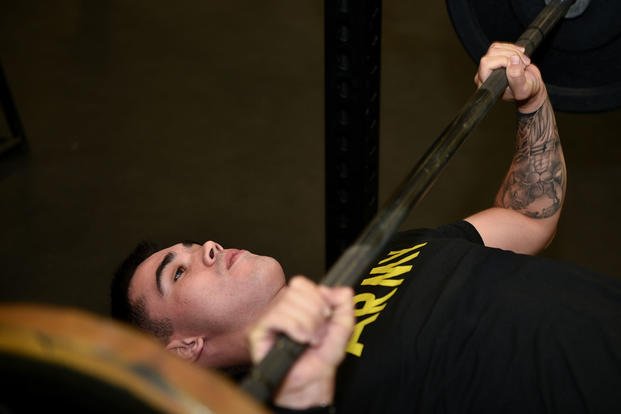
Foundation Building
You have to build a foundation of fitness before expecting stellar results. I recommend that the group focus on stretching and multiple sets of low to medium repetitions to build a solid core before advancing to maximum sets of two-minute testing. By building a foundation on the push-ups, sit-ups, pull-ups and running, the PT group will grow in a steady progression.
Remember to work both sides of the muscles in order to create strength balances near the major joints of the body, as well as to prevent injury. For instance, the opposing muscle groups of the chest/upper back, biceps/triceps, thighs/hamstrings and stomach/lower back should be considered when preparing a fitness plan.
For instance:
Push-ups flex the triceps, chest and shoulders while stretching the upper back. Exercising the upper back also should be considered. See the lower-back injury prevention link below for three great exercises to help with upper-body balance.
Sit-ups, crunches and other ab exercises engage the stomach muscles while the lower-back muscles are stretched or strained.
Group PT
Working out with a group of people with a similar fitness goal should not be as difficult as it is. But with a variety of standards and fitness levels of large groups, as well as personal motivation levels, group PT in the military is extremely difficult. It seems that about half the group who are fit will receive a marginal workout at best, while unfit members of the group will border on injury and overexert themselves for their fitness level. See the link below to a sample group PT program that I developed for remedial PT groups.
Push-ups
For the PFT programs that require push-ups, here is a way to build push-ups in a short period of time. Click the links below for details to add up to 50%-100% to your push-up totals in as little as 14 days.

Running
Running is by far the most challenging part for all branches of service. However, improving running while preventing injuries can be taught as simply as performing a push-up. Below are running plans the group PT leader can use to help increase endurance and decrease run times. Take baby steps when it comes to running. If you never have run, you should walk a quarter-mile, run a quarter-mile and build up accordingly until 1.5 miles is doable in a fast walk or slow run. Once you build that foundation, you can add to your speed.
Sit-ups
For men and women, sit-ups or curl-ups are the easiest exercise to perform at above-average levels. It takes only a few short weeks to improve your abdominal strength and endurance, and for most, it is a matter of learning the proper pace. Most people start off too fast and burn out in a two-minute period. See the articles linked below for more information.
Overall, the PFT can cause stress for those who are not prepared properly and can be an exceptional stress reliever for those who seek to maximize the scores. The mindset of merely surviving by reaching the minimum standards in the PFT is completely different from those who use the PFT to compete with their shipmates to win individual events. Both mindsets can cause anxiety, and if you have not fueled yourself properly before the PFT, you will not perform at your maximum levels. See the article on PFT anxiety for answers to alleviating this stress before testing.
PFT Anxiety
Anxiety is prevalent in our world. It occurs at home, during work or social situations while playing sports or taking tests. Academic testing anxiety is very similar to physical test-taking anxiety. Before taking a chemistry test at the Naval Academy, I felt the same when I took the Navy SEAL PFT.
Tape Test
The last problem area is the tape test, which measures the body circumference. The "Body Composition Tests" article will assist you with ideas to lose or gain the inches where needed.
This article should prove to be an all-inclusive reference guide for you to prepare yourself, and your command, for accepting the challenge of scoring above average on the PFT -- as well as preparing PFT and tape-test failures to reach their goals and surpass them.
(Editor's note: The Air Force became the first service to get rid of the tape test. The Army also is strongly considering it.)
Stew Smith is a former Navy SEAL and fitness author certified as a Strength and Conditioning Specialist (CSCS) with the National Strength and Conditioning Association. Visit his Fitness eBook store if you're looking to start a workout program to create a healthy lifestyle. Send your fitness questions to stew@stewsmith.com.
Want to Learn More About Military Life?
Whether you're thinking of joining the military, looking for fitness and basic training tips, or keeping up with military life and benefits, Military.com has you covered. Subscribe to Military.com to have military news, updates and resources delivered directly to your inbox.
